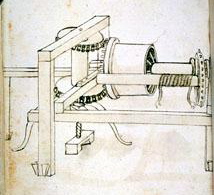Categories: ME112Notes, ME112AssignmentsHelp
 Model of Brunelleschi's hoist at Institute and Museum of the |
On this page... (hide)
|
1. Assignment 1
The first assignment involves a review of free-body diagrams and combined bending + torsion loading. It is a review of ME80, with application to a power transmission system in a machine. The analysis is similar to what you will soon be doing for your own machines.
1.1 Background
The problem is based on a real machine, developed by the Renaissance artist/engineer Filippo Brunelleschi during the period 1420-1425. The machine was used to hoist large sandstone and marble blocks for completion of the cupola of the cathedral in Florence. Brunelleschi had won a competition for the cupola design and construction with his radical concept of building the dome as a series of rings, gradually working toward the top (somewhat like making an igloo). With this approach, there was no need for "centering" or scaffolding to support the partially completed dome.
In addition to being a remarkable sculptor, painter and architect, Brunelleschi was something of an efficiency freak. It bothered him that the amount of time taken for an ox-driven hoist to raise a small block weighing 500 lbs should be the same as the time needed to lift a huge one weighing 2000 lbs. It bothered him even more that when the block reached the top of the cupola, the oxen had to be un-harnessed and re-harnessed to change the direction of the hoist and lower the lifting tackle back to the ground.
Brunelleschi's solution was a three-speed, reversible hoist. This was a novel concept and drew much admiration from other Renaissance artists and engineers (for example, a young Leonardo da Vinci) who, happily, have provided sketches of it that survive to this day:
 |
|
Brunelleschi's machine includes other features that presage the machine elements we will be exploring in ME112 including gears and bearings. Part of what is remarkable about this machine is that it predates any notion of engineering analysis, beam theory, etc. by a few hundred years. It was designed by scaling up from working models, using a great deal of intuition.
1.2 Videos and images
- Simulations of the hoist from the Institute and Museum of the History of Science, Florence
- Video clip about the hoist from the Institute and Museum of the History of Science, Florence
- If the above sites don't play well, you can try these: Attach:hoist.mov, Attach:hoist2.mov (download and play)
- A CAD model of the machine (from Harvard libraries).
- Brunelleschi's machine -- Longer video clip of the story behind the machine designed by Filippo Brunelleschi in Florence in the 1400s to help him complete the cupola of the cathedral.
- Animated video by National Geographic about Brunelleschi's Dome.
1.3 Engineering help
- Review of free-body diagram construction for a shaft with gears -- from Prof. Sheppard's textbook. [Sheppard, S.D. and Tongue, B.H, Statics : Analysis and Design of Systems in Equilibrium, Wiley] - zipped collection of pages.
- Beam stress and deflection -- single concentrated load and simple end conditions. (can use superposition for multiple loads.)
- Beam View Java beam applet -- cute program from U. Vt. that lets you specify loads, end conditions and it draws the shear and moment diagram and computes deflections. Check units!
- Specifications on power output of animals -- Power, force exerted, and energy output of draft animals put together by Tim Lovett
1.4 Brunelleschi refs
- King, R. Brunelleschi's Dome: How a Renaissance Genius Reinvented Architecture, Penguin Books, 2000. -- A great book. Engaging and informative.
- https://en.wikipedia.org/wiki/Filippo_Brunelleschi
- Brunelleschi twiki site for ME21N and ME122F (taught in 2004-2005).
- References List from ME122F
- Prager, F.D. and Scaglia, G. Brunelleschi: Studies of His Technologies and Inventions. MIT Press, 1970.

